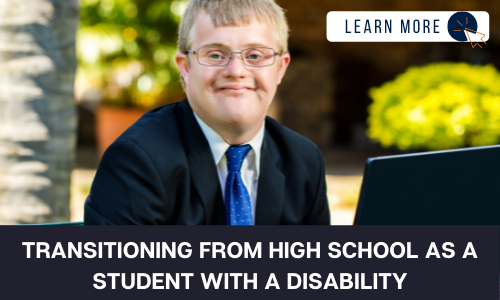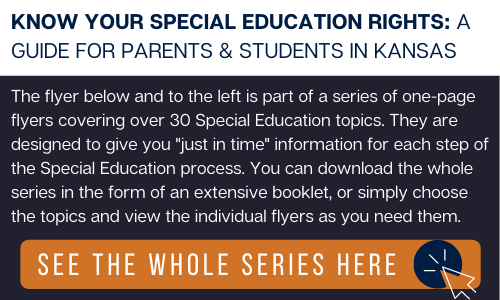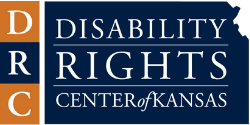Transitioning from high school as a student with a disability
 |
 |
PDF Version: Transitioning from high school as a student with a disability
PDF Version: Full Guide of all 30+ Flyers (Compiled as a Booklet)
What is a transition plan?
A transition plan helps your child prepare for life after high school. It is part of the Individualized Education Program (IEP). In Kansas, the transition starts when a student turns 14. The IEP must be updated every year. The transition plan should be reviewed and updated yearly.
Who gets a transition plan?
Every student with a disability who has an IEP will have a transition plan. This starts at age 14. This means that the student’s input is required. The plan is all about what the student wants to do after high school.
What does a transition plan include?
A transition plan must have at least two goals – a postsecondary education/training goal and an employment goal. Postsecondary goals are about what education and training the students wants after high school. Employment goals are about where they want to work after high school. The goals should list the student’s true hopes and dreams. Each student is different. Each student’s hopes and dreams will be different, too. Examples of things that could be in the transition plan are:
• Education and/or training after high school
• Independent living skills (this could be things like making meals, budgeting, taking care of a home, paying bills, and how to take care of yourself)
• Employment
• Services that the student will need as part of transition
• Responsibilities of various agencies during the student’s transition (when appropriate)
- An example of this is Kansas Vocational Rehabilitation (VR) services. If VR or some other agency is added to the IEP, that agency can begin going to the IEP meetings. You have to give written permission for an agency to be invited to attend IEP meetings.
The iTransition app is a free, user-friendly, web and device-based app that empowers students to have a successful school to adult life transition. Try it out! www.iTransitionKS.org
Transition Planning - What happens before age 14:
The school should do a transition assessment. This will be in the areas of education and training, employment, and independent living skills (if necessary). It needs to be appropriate for the student’s age. This assessment will be used to make the postsecondary goals for the transition plan.
When a student is 14, more services that they will need to transition out of high school will be added to the IEP and the transition plan. This could be community experiences like working, job training, banking, shopping, transportation, counseling, or recreational activities.
Age 14 is also when they might add daily living skills to the transition plan.
At age 14, a functional vocational evaluation might be done, if appropriate. This would cover things like job interests and skills. The IEP team can then use that information to make changes to the IEP or transition plan, if needed.
Transition Planning - What happens at age 16:
When a student is 16, more services that they will need to transition out of high school will be added to the IEP and the transition plan. This is also the age when the transition plan will add information about the responsibilities that various agencies will have during your student’s transition. This is only included if it is appropriate for the student. An example of this is Kansas Vocational Rehabilitation (VR) services. If VR or some other agency is added to the IEP, that agency can begin going to the IEP meetings. You must give written permission for an agency to be invited to attend IEP meetings.
Transition Planning - What happens at age 17:
When a student turns 17, the IEP team has to let them and their parents know that they will soon be old enough to make their own decisions. Under Kansas law, people can make their own decisions at 18. This is called age of majority. In the IEP, the school has to document that they explained this to the parents and student.
If the student is not able to make decisions for themselves, there are many options and alternatives to guardianship, such as durable powers of attorney and supported decision making. Guardianship should be a last resort. If a guardian is appointed for a student, the document to the right (Alternatives to Guardianship & Conservatorship) can help inform the student about their rights. Families and students who want to know more about alternatives to guardianship should contact the Disability Rights Center of Kansas and Families Together.
Will my student receive special education services in a college class that they take while they’re still in high school?
Sometimes, students take college classes while they’re in high school. In these college classes, the school technically does not have to follow the IEP or provide the services in the IEP. However, the college must make reasonable accommodations for the student with a disability under the Americans with Disabilities Act. The college cannot discriminate based on disability. The student and/or parent must contact the college’s student disability services office to receive these accommodations.
See more: How can VR help with my child's transition?
Sources & Additional Resources:
Alternatives to Guardianship & Conservatorship. Disability Rights Center of Kansas.
Transition in the IEP: What Parents and Students Need to Know. Kansas State Department of Education.
Supported Decision-Making. Kansas University Center on Developmental Disabilities.
Disclaimer: This fact sheet is not intended to provide specific legal advice. If you need legal advice, please contact an attorney. Only an attorney can give you specific legal advice based on your particular situation. We try to update our materials regularly, but the law can change frequently. This publication is based on the law at the time that it was written. Future changes in the law could make information in this fact sheet inaccurate.
.png)





